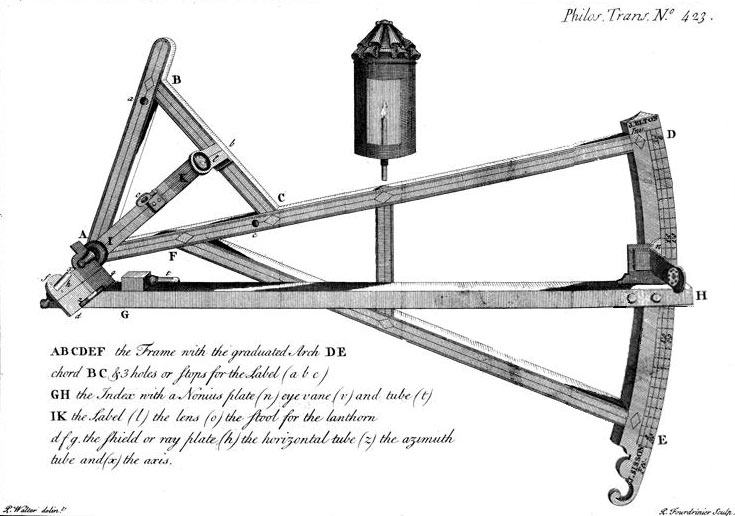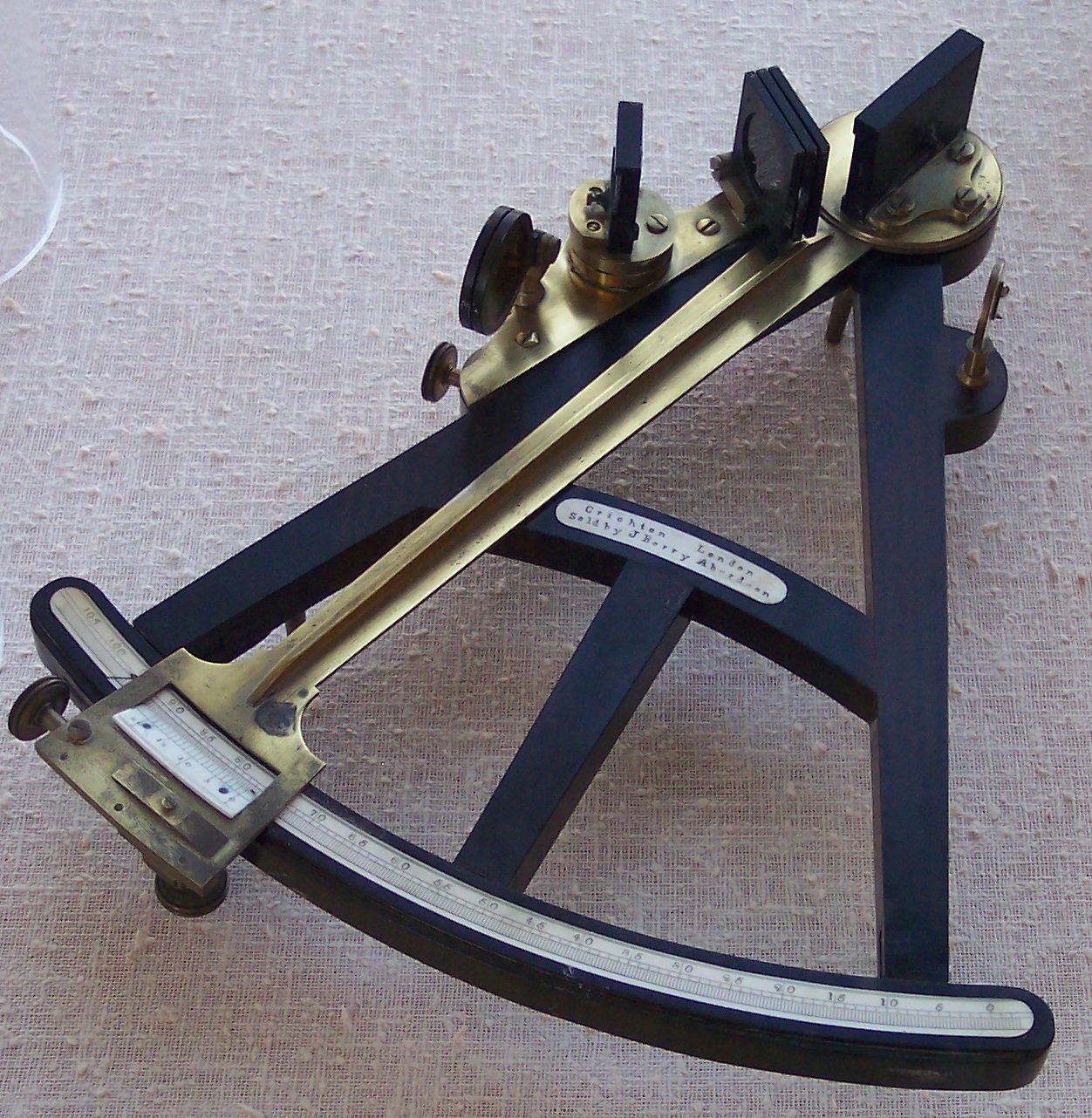|
Back Staff
The backstaff is a navigational instrument that was used to measure the altitude of a celestial body, in particular the Sun or Moon. When observing the Sun, users kept the Sun to their back (hence the name) and observed the shadow cast by the upper vane on a horizon vane. It was invented by the English navigator John Davis, who described it in his book ''Seaman's Secrets'' in 1594. Types of backstaffs Backstaff is the name given to any instrument that measures the altitude of the sun by the projection of a shadow. It appears that the idea for measuring the sun's altitude using back observations originated with Thomas Harriot. Many types of instruments evolved from the cross-staff that can be classified as backstaves. Only the Davis quadrant remains dominant in the history of navigation instruments. Indeed, the Davis quadrant is essentially synonymous with backstaff. However, Davis was neither the first nor the last to design such an instrument and others are considered here a ... [...More Info...] [...Related Items...] OR: [Wikipedia] [Google] [Baidu] |
Celestial Navigation
Celestial navigation, also known as astronavigation, is the practice of position fixing using stars and other celestial bodies that enables a navigator to accurately determine their actual current physical position in space (or on the surface of the Earth) without having to rely solely on estimated positional calculations, commonly known as "dead reckoning", made in the absence of satellite navigation or other similar modern electronic or digital positioning means. Celestial navigation uses "sights", or timed angular measurements, taken typically between a celestial body (e.g. the Sun, the Moon, a planet, or a star) and the visible horizon. Celestial navigation can also take advantage of measurements between celestial bodies without reference to the Earth horizon, such as when the Moon and other selected bodies are used in the practice called "lunars" or lunar distance method, used for determining precise time when time is unknown. Celestial navigation by taking sights of the ... [...More Info...] [...Related Items...] OR: [Wikipedia] [Google] [Baidu] |
Elton's Quadrant
An Elton's quadrant is a derivative of the Davis quadrant. It adds an index arm and artificial horizon to the instrument. It was invented by John Elton a sea captain who patented his design in 1728Bennett, Jim, "Catadioptrics and commerce in eighteenth-century London", in History of Science, vol xliv, 2006, pages 247-277. and published details of the instrument in the Philosophical Transactions of the Royal Society in 1732.Elton, John, ''The Description of a New Quadrant for Taking Altitudes Without an Horizon, Either at Sea or Land'', Philosophical Transactions of the Royal Society, Vol 37, No. 423, 1731-1732. Construction This instrument clearly reflects the shape and features of the Davis quadrant. The significant differences are the change in the upper arc to a simple triangular frame and the addition of an index arm. The triangular frame at the top spans 60° as did the arc on the backstaff. The main graduated arc subtends 30° as in the backstaff. The 30° arc is gradu ... [...More Info...] [...Related Items...] OR: [Wikipedia] [Google] [Baidu] |
Charles Hutton
Charles Hutton FRS FRSE LLD (14 August 1737 – 27 January 1823) was a British mathematician and surveyor. He was professor of mathematics at the Royal Military Academy, Woolwich from 1773 to 1807. He is remembered for his calculation of the density of the earth from Nevil Maskelyne's measurements collected during the Schiehallion experiment. Life Hutton was born on Percy Street in Newcastle upon Tyne in the north of England, the son of a superintendent of mines, who died when he was still very young. He was educated at a school at Jesmond, kept by Mr Ivison, an Anglican clergyman. There is reason to believe, on the evidence of two pay-bills, that for a short time in 1755 and 1756 Hutton worked in the colliery at Old Long Benton. Following Ivison's promotion to a living, Hutton took over the Jesmond school, which, in consequence of his increasing number of pupils, he relocated to nearby Stotes Hall. While he taught during the day at Stotes Hall, which overlooked Jesmond De ... [...More Info...] [...Related Items...] OR: [Wikipedia] [Google] [Baidu] |
George Adams (scientist, Died 1773)
George Adams (c. 1709–1773) was an English instrument maker and science writer. His son George Adams, who carried on the business, was also known as an instrument maker and optician. Life He was the eldest surviving son of Morris Adams, a cook, and his wife Mary, and was baptised in 1709. He was an apprentice to instrument makers, James Parker who died, and then Thomas Heath. He went into business in 1734, in Fleet Street, London. Instruments File:Geo. Adams microscope - National Museum of Nature and Science, Tokyo - DSC07195.JPG, George Adams microscope in the National Museum of Nature and Science, Tokyo File:George Adams sea quadrant.jpg, Sea Quadrant by George Adams, at The Mariners' Museum File:George Adams handwriting.jpg, Serial number, date, and signature from George Adams' quadrant, at The Mariners' Museum Bibliography Adams was best known for ''A Treatise Describing the Construction and Explaining the Use of New Celestial and Terrestrial Globes'' (London: 176 ... [...More Info...] [...Related Items...] OR: [Wikipedia] [Google] [Baidu] |
Octant (instrument)
The octant, also called a reflecting quadrant (instrument), quadrant, is a reflecting instrument used in navigation. Etymology The name ''octant'' derives from the Latin ''octans'' meaning ''eighth part of a circle'', because the instrument's arc is one eighth of a circle. ''Reflecting quadrant'' derives from the instrument using mirrors to reflect the path of light to the observer and, in doing so, doubles the angle measured. This allows the instrument to use a one-eighth of a Turn (geometry), turn to measure a quarter-Turn (geometry), turn or Circular sector, quadrant. Origin of the octant Newton's reflecting quadrant Isaac Newton's reflecting quadrant was invented around 1699. A detailed description of the instrument was given to Edmond Halley, but the description was not published until after Halley's death in 1742. It is not known why Halley did not publish the information during his life, as this prevented Newton from getting the credit for the invention that is gene ... [...More Info...] [...Related Items...] OR: [Wikipedia] [Google] [Baidu] |
Vernier Scale
A vernier scale, named after Pierre Vernier, is a visual aid to take an accurate measurement reading between two graduation markings on a linear scale by using mechanical interpolation, thereby increasing resolution and reducing measurement uncertainty by using vernier acuity to reduce human estimation error. It may be found on many types of instrument measuring linear or angular quantities, but in particular on a vernier caliper which measures internal or external diameter of hollow cylinders. The vernier is a subsidiary scale replacing a single measured-value pointer, and has for instance ten divisions equal in distance to nine divisions on the main scale. The interpolated reading is obtained by observing which of the vernier scale graduations is coincident with a graduation on the main scale, which is easier to perceive than visual estimation between two points. Such an arrangement can go to a higher resolution by using a higher scale ratio, known as the vernier constant. A ... [...More Info...] [...Related Items...] OR: [Wikipedia] [Google] [Baidu] |
Benjamin Cole (instrument Maker)
Benjamin Cole (1695–1766) was an English surveyor, cartographer, instrument maker, engraver and bookbinder living in Oxford. His sons William and Benjamin were also instrument makers in London, while another son, Maximilian, was an engraver in Oxford. Works Benjamin Cole had a long-standing interest in freemasonry and engraved the frontispiece to the 1756 ''Book of Constitutions'' after succeeding John Pine in 1743 as official engraver to the Grand Lodge. Cole drew up the ward maps for the first edition of the historian and topographer William Maitland's (c.1693–1757) posthumous ''History of London from Its Foundation to the Present Time'' (1769). (Cf. John Entick's ''New and Accurate History and Survey of London'' of 1766.) His music engravings included a collection by John Frederick Lampe with a setting of the ''Entered Apprentice's Song''. In 1728/9, he published a copy of the ''Old Charges'' with speeches by two Freemasons, Francis Drake and architect Edward Oakley. ... [...More Info...] [...Related Items...] OR: [Wikipedia] [Google] [Baidu] |
Thomas Hood (mathematician)
Thomas Hood (1556–1620) was an English mathematician and physician A physician (American English), medical practitioner (Commonwealth English), medical doctor, or simply doctor, is a health professional who practices medicine, which is concerned with promoting, maintaining or restoring health through th ..., the first lecturer in mathematics appointed in England, a few years before the founding of Gresham College. He publicized the Copernican theory, and discussed the nova SN 1572. (Tycho's Nova). He also innovated in the design of mathematical and astronomical instruments. Life He entered Trinity College, Cambridge in 1573, and graduated B.A. in 1578; he was elected to a fellowship in the same year, and graduated M.A. in 1581. His Cambridge licence to practice as a physician was from 1585. He was approached to lecture in mathematics in 1582, by the merchant Thomas Smythe. The lectures in fact began in 1588. W. W. Rouse Ball, ''A History of the Study of Mathematics ... [...More Info...] [...Related Items...] OR: [Wikipedia] [Google] [Baidu] |
Almucantar
An almucantar (also spelled almucantarat or almacantara) is a circle on the celestial sphere parallel to the horizon. Two stars that lie on the same almucantar have the same altitude. The term was introduced into European astronomy by monastic astronomer Hermann Contractus of Reichenau, Latinized from the Arabic word ' ("the almucantar, sundial", plural: '), derived from ' ("arch, bridge") Almucantar staff An almucantar staff is an instrument chiefly used to determine the time of sunrise and sunset, in order to find the amplitude and consequently the variations of the compass. Usually made of pear tree or boxwood, with an arch of 15° to 30°,May, William Edward, ''A History of Marine Navigation'', G. T. Foulis & Co. Ltd., Henley-on-Thames, Oxfordshire, 1973, it is an example of a backstaff. The sun casts that shadow of a vane (B in the adjacent image) on a ''horizon vane'' (A). The horizon vane has a slit or hole to allow the observer to see the horizon in the distanc ... [...More Info...] [...Related Items...] OR: [Wikipedia] [Google] [Baidu] |





